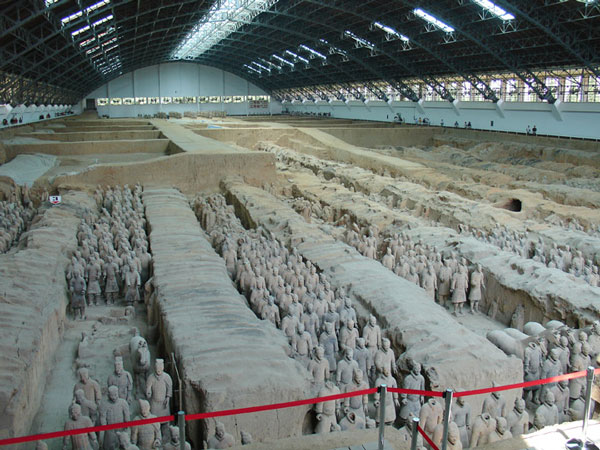Find the culprit who burned the tomb of Tan Thuy Hoang
Archaeologists have excavated 120 terracotta warriors since the Qin Shihuang period (221-206 BC) in Shaanxi, China. This excavation also found unprecedented worship items such as drum drums, colored shields .
Starting in 2009, this is the third archaeological excavation involving the Qin dynasty, after 1974 and 1985, according to the Guardian.
The terracotta warriors, discovered at the World Heritage site of Qin Shihuang in Xian City, were previously deprived of weapons, smashed and burned, according to the Shanghai Daily.

Excavation area of the tomb of Qin Shi Huang
According to officials of the Museum of Terracotta Warriors and War Horse of Qin Shihuang, Xiang Yu, a contemporary general, who overthrew the Qin Dynasty was said to be the author of the tomb of Qin Shi Huang.
'We found a large number of red clay, charcoal and excavations in the archaeological area ,' said Tham Mao Thang, leader of the archaeological group. 'There are signs of arson'.
Since 2009, thousands of earthen warriors and horses have been found, the size of real people, at three excavation sites in the area.
In 1974, farmers in Lindong District, Xian City, Shaanxi accidentally found terracotta statues in an area near the tomb of Qin Shihuang, the unified emperor of China in the century. 3rd BC.
More than 8,000 warriors, 130 chariots, 520 horses and 150 cavalry were excavated at an area of 14,000 square meters. This is just a small corner of the tomb area.
However, most weapons (real things) like spears, swords and jacks have disappeared, said Cao Wei, deputy director of the museum.
'Main Category Vu, the head of the new rebel force has enough power, time and motivation to rob the tomb area , ' said the archaeologist Tham.
The rank of Vu hated Qin Shihuang, and it was his motive for destroying 'tomb guards' (terracotta warriors) of the Qin king. Xiang Yu also needed weapons to fight against the Qin army because at that time, the Qin Dynasty banned weapons production all over China, archaeologists said.
Most terracotta statues in this excavation have been broken into pieces and scientists have to reorganize them. There has long been a question of a burial site, but no one has proof of the excavation this time.
- The mystery of the tomb Qin Shihuang
- The three most mysterious historical artifacts in China constantly challenge scientists' intellect
- Why not break the wall between terracotta warriors in Mausoleum of Qin Shihuang?
- Tan Thuy Hoang's terracotta army made from 2 places
- New theory about terracotta army Qin Shihuang
- The truth falls back on the culprit who burned into Rome
- More clues Tan Thuy Hoang used to find immortal drugs
- Found a thousand-year-old beef soup in a tomb
- Egypt examined Tut's tomb to find Queen Nefertiti
- Quang Binh: White whale weighs 10 tons washed up on the coast
- Find remains in the mysterious tomb of Alexander the Great
- Discover the mysterious tomb without any corpse
 Discovered an ancient centipede fossil 99 million years old
Discovered an ancient centipede fossil 99 million years old Discovered bat-like dinosaurs in China
Discovered bat-like dinosaurs in China Discovered a 200-year-old bronze cannon of the coast
Discovered a 200-year-old bronze cannon of the coast Discover 305 million-year-old spider fossils
Discover 305 million-year-old spider fossils